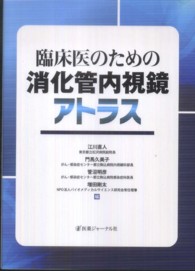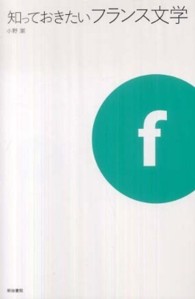- ホーム
- > 洋書
- > 英文書
- > Business / Economics
Full Description
This 2-volume set constitutes the post proceedings of the 22nd IFIP WG 5.1 International Conference on Product Lifecycle Management, PLM 2025, which took place in Seville, Spain, July 2025.
The 79 full papers presented in this volume were carefully reviewed and selected from 143 submissions.
The papers are organized in the following topical sections:
Part I: Digital Twin and Smart Systems; AI and Data-Driven Innovation; Sustainable and Circular Product Lifecycle.
Part II: Model-Based Engineering (MBE) and System Engineering; Organizational Transformation and Strategy; Interoperability and Integration Technologies; Human-Centric and Educational Innovation.
Contents
.- Model-Based Engineering (MBE) and System Engineering.
.- A systemic integrated approach to achieve optimal choice regarding end users' needs by combining Archi-TRIZ and QFD for building design process.
.- Expert-Driven Design and Validation of a CAD Model Quality Assessment Instrument.
.- Perspectives on Generative AI versus Ontology-based Engineering Systems in aerospace manufacturing design.
.- COSMOS framework- A holistic mapping of the dimensions of design and implications for Product Lifecycle Management (PLM).
.- Preliminary application of Large Language Models for Scope Model generation in Models for Manufacturing.
.- Ontology-Based Engineering System for Knowledge-Driven Manufacturing of Customised Aerospace Parts.
.- How Can Machine Learning and Discrete Event Simulation Contribute to Optimize on Stock Supply Chains: A Case Study.
.- Exploring the intersection of enterprise architecture, consumer experience and sustainable development goals: Contributions, challenges and application.
.- A New Approach for Aircraft Equipment Layout Design Process.
.- A hybrid knowledge extraction approach to support early concurrent engineering in the aerospace industry.
.- Approach for the combination of PLM and MBSE in the early Product Development Stages.
.- A Comprehensive Framework for GxP Compliance Across the Vaccine Lifecycle.
.- A feasible AI application identification approach for enhancing MDAO processes.
.- Getting Things Done: How to Make Simulation Data FAIR and Ready to Reuse.
.- Organizational Transformation and Strategy.
.- How to Better Integrate Game Theory into Technological Forecasting: Some Challenges to Tackle.
.- Lean Added Value in the Context of Industry 5.0 for Designing Lean 5.0 Manufacturing Systems.
.- From Project Management Office to Value Management Office: A Systematic Review on the Transformation of Project Management.
.- SMART: A Situational Awareness Framework for Real-Time Monitoring and Reporting in Construction.
.- Maturity Model for Pay-Per-Use Business Models in Non-Road Mobile Machinery Manufacturing.
.- Enhancing Workforce Competency through Structured Hybrid Training: A Product Lifecycle Approach for Industry 4.0.
.- Effect of internal & external financing on labor productivity - (2009-2014) panel data study of Ecuadorian companies.
.- Interoperability and Integration Technologies.
.- Ontology for Models' Interoperability: A Case Study for Design and Simulation.
.- A Graph-Based Approach for a Digital Battery Passport.
.- Concept model for non-geometrical information within product life cycle.
.- Comparison and Proposal for the Integration of ASIT and C-K: Case Study on the Management of Empty Material in a Postal Organization.
.- Integrating Digital Product Passports Into PLM Systems.
.- Adoption of Blockchain Technology in Enhancing Supply Chain for Sustainable Practices: Case Study review and Proposed Framework.
.- Human-Centric and Educational Innovation.
.- Linking SysMLv2 with Systems Platforms to support Model-Based Integration, Verification, Validation and Qualification.
.- PLM Meta-UI: Toward an End-User Solution for Personalizing Product Lifecycle Management applications.
.- Product Lifecycle Management towards Industry 5.0: a descriptive analysis.
.- Analytics Education: conceptual network structure, key challenges and opportunities.
.- AI thematic areas and use cases for construction life cycle using social media.
.- Innovative and Sustainable Product Design and Additive Manufacturing: from Research Trends to Empirical Experimentation.
.- Modelling Scrum Product Goal with North Star Metric approach.
.- The Intersection of Economic Status, Aspiration, and Colour Psychology in Apparel Consumer Behaviour.
.- Detailing the Circular Economy Rebound Effect reference model through Rebound Effect mechanisms.








